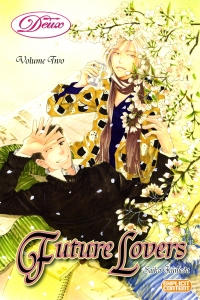In celebration of the overturning of Proposition 8, I thought I’d throw out a question: what are some of your favorite same-sex couples in comics? I’ll start.
The thing that I love best about straight-laced Kento and sly, cynical Akira in Future Lovers, beyond their opposites-attract charm, is the fact that their romance doesn’t exist in a void. They deal with work and family as a part of the nuts and bolts of their relationship. They’re adorable together, but they also feel very real thanks to the rounded lives creator Saika Kunieda has given them.
There really isn’t anything I don’t like about bubbly Rica and worldly Miho in Rica Takashima’s Rica ‘tte Kanji!? It’s an unabashedly happy story of young love and emerging identity, which still seems all too rare a specimen in any medium.
So, which pairings make you happy?



Rom com
One of the things that was confirmed for me when I started reading manga in earnest was that I’m a big sucker for romance in the comic form. I’d always been more inclined to the soap operatic elements of super-hero comics than the adventure end of things, and many manga series allowed me to forego the flying fists entirely. With the imminent arrival of Valentine’s Day, here are some of my favorites:
Antique Bakery, by Fumi Yoshinaga (DMP): Okay, it’s more about coping with the challenges of adulthood in general than romance in particular, but I think Yoshinaga is at her funniest, sharpest, and most generous when she examines the bittersweet qualities of interpersonal relationships. It’s almost all sighs instead of swoons, but a story doesn’t have to offer anything resembling “happily ever after” to be romantic in its own way. All four volumes are available.
Emma, by Kaoru Mori (CMX): On the other hand, this one is all swoons, all the time, and it is glorious. It follows the fraught-with-obstacles romance of a housemaid and a member of the upper class (though tellingly, not the aristocracy), rendered with breathtaking emotional precision and lush, detailed illustrations. Only one more volume is due from this series.
Fake, by Sanami Matoh (Tokyopop): You’ve got to either embrace or ignore the wooly-headed stupidity of the police procedural aspects of this tale of detectives in lust, but it’s worth it. It’s a seven-volume pas de deux between bisexual Dee and undecided Ryo, fighting (snicker) crime and finding their way towards each other. Don’t think; just read.
Genshiken, by Kio Shimoku (Del Rey): Like Antique Bakery, this one isn’t a romance, per se, but some of the undercurrents kill me. Shimoku plays me like a fiddle with a will-they-won’t-they-probably-not subplot that runs throughout the nine volumes of the series.
Love Roma, by Minoru Toyoda (Del Rey): This one presents high-school romance in all of its goofy glory. This review at Sleep is for the Weak tells you everything you need to know about the book’s considerable virtues. All five volumes of its run are available.
Maison Ikkoku, by Rumiko Takahashi (Viz): Fifteen (thanks, Jun) volumes of romantic misunderstandings and near-misses should be exhausting, but it isn’t. Takahashi keeps her options open and populates her fictional boarding house with a likeable (and likeably awful) cast of characters that keeps things hopping. It’s heartfelt and funny in equal measure, a real classic.
Paradise Kiss, by Ai Yazawa (Tokyopop): Creative passion and young lust clash in this sexy soap about student designers and their muse, a gawky grind who discovers her inner supermodel (and lots of other stuff). If you’ve been enjoying Yazawa’s Nana (Viz), you owe it to yourself to give this one a look. (And if there was ever a series that begged for a glamorous, done-in-one omnibus treatment, it’s this one. Or maybe Antique Bakery. Or both.)
So what are your swoon-worthy choices?
Edited to add one more, because I can’t believe I forgot it:
Rica ‘tte Kanji!?, by Rica Takashima (ALC): This is perhaps the most adorable backlash comic ever. After growing seriously weary of the often tragic outcomes of most manga tales of lesbian love, Takashima decided to take a more lighthearted, positive approach. The result is this charming story of the budding romance between a young innocent and the not-much-older-but-certainly-wiser woman she meets in Tokyo’s gay district.